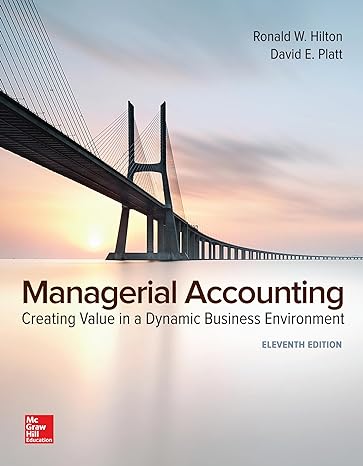The Midwest Division of the Paibec Corporation manufactures subassemblies that are used in the corporations final products.
Question:
The Midwest Division of the Paibec Corporation manufactures subassemblies that are used in the corporation’s final products. Lynn Hardt of Midwest’s Profit Planning Department has been assigned the task of determining whether a component, MTR–2000, should continue to be manufactured by Midwest or purchased from Marley Company, an outside supplier. MTR–2000 is part of a subassembly manufactured by Midwest.
Marley has submitted a bid to manufacture and supply the 32,000 units of MTR–2000 that Paibec will need for 20x1 at a unit price of $17.30. Marley has assured Paibec that the units will be delivered according to Paibec’s production specifications and needs. While the contract price of $17.30 is only applicable in 20x1, Marley is interested in entering into a long-term arrangement beyond 20x1.
Hardt has gathered the following information regarding Midwest’s cost to manufacture MTR–2000 in 20x0. These annual costs will be incurred to manufacture 30,000 units.

Hardt has collected the following additional information related to manufacturing MTR–2000.
• Direct materials used in the production of MTR–2000 are expected to increase 8 percent in 20x1.
• Midwest’s direct-labor contract calls for a 5 percent increase in 20x1.
• The facilities used to manufacture MTR–2000 are rented under a month-to-month rental agreement.
Thus, Midwest can withdraw from the rental agreement without any penalty. Midwest will have no need for this space if MTR–2000 is not manufactured.
• Equipment leasing costs represent special equipment that is used in the manufacture of MTR–
2000. This lease can be terminated by paying the equivalent of one month’s lease payment for each year left on the lease agreement. Midwest has two years left on the lease agreement, through the end of the year 20x2.
• Forty percent of the other manufacturing overhead is considered variable. Variable overhead changes with the number of units produced, and this rate per unit is not expected to change in 20x1. The fixed manufacturing overhead costs are expected to be the same across a relevant range of zero to 50,000 units. Equipment other than the leased equipment can be used in Midwest’s other manufacturing operations.
John Porter, divisional manager of Midwest, stopped by Hardt’s office to voice his concern regarding the outsourcing of MTR–2000. Porter commented, “I am really concerned about outsourcing MTR–
2000. I have a son-in-law and a nephew, not to mention a member of our bowling team, who work on MTR–2000. They could lose their jobs if we buy that component from Marley. I really would appreciate anything you can do to make sure the cost analysis comes out right to show we should continue making MTR–2000. Corporate is not aware of the material increases and maybe you can leave out some of those fixed costs. I just think we should continue making MTR–2000!”
Required:
1.
a. Prepare an analysis of relevant costs that shows whether or not the Midwest Division of Paibec Corporation should make MTR–2000 or purchase it from Marley Company for 20x1.
b. Based solely on the financial results, recommend whether the 32,000 units of MTR–2000 for 20x1 should be made by Midwest or purchased from Marley.
2. Identify and briefly discuss three qualitative factors that the Midwest Division and Paibec Corporation should consider before agreeing to purchase MTR–2000 from Marley Company.
3. By referring to the standards of ethical conduct for managerial accountants given in Chapter 1, explain why Lynn Hardt would consider the request of John Porter to be unethical.
Step by Step Answer:

Managerial Accounting Creating Value In A Dynamic Business Environment
ISBN: 9781259569562
11th Edition
Authors: Ronald W.Helton, David E. Platt





